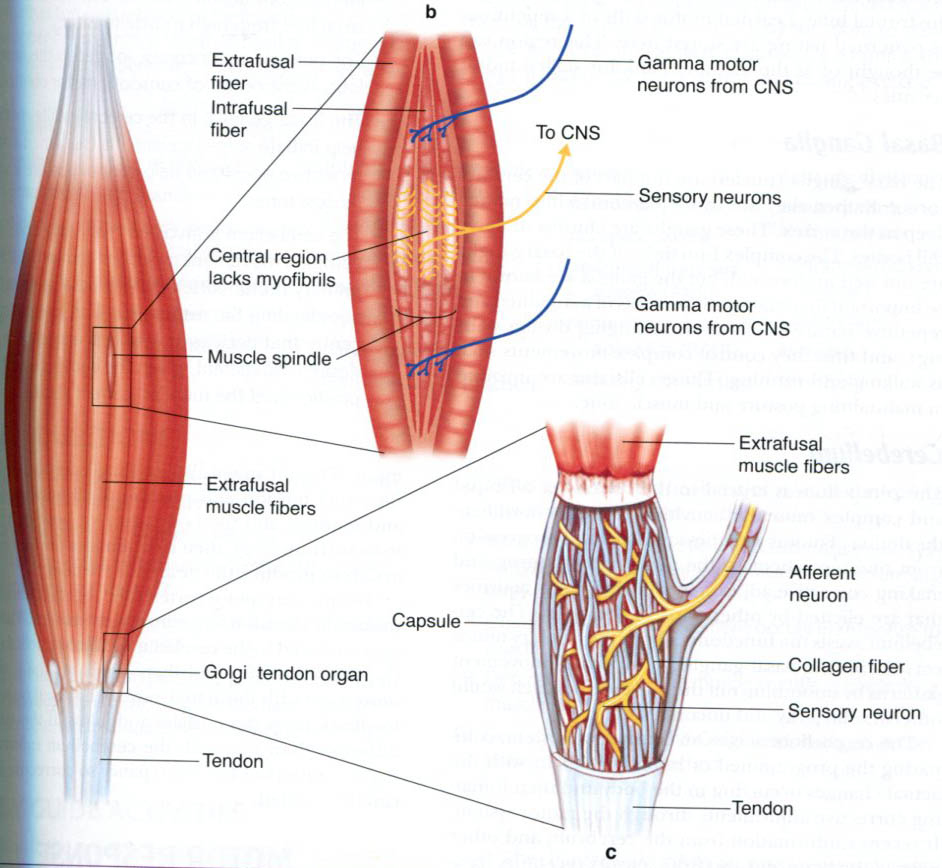The Human Brain
Many Images enlarge: click on them. - Top
- Sensory Receptors
- Threshold
- Adaptation
- Structure and Function of Receptors
- Somatic Sensation
- Receptors in Muscles and Tendons
- Tutorial Index
SENSORY RECEPTORS

* The diagram shows the mechanical stimulus to a Pacinian corpuscle, and the generator potential (depolarisation) in the nerve ending. This is a rapidly adapting receptor and responds to the onset and removal of the mechanical stimulus.
| Sensory Receptors |
|---|
| Sensory Receptors are transducers in nerve endings that respond to a stimulus of a specific nature (mechanical, vibratory, thermal, or chemical). They signal the intensity of the stimulus by producing a generator potential (a depolarisation in the nerve ending) that increases the number of impulses generated per second as a function of the strength of the stimulus. |
| The depolarisation that occurs during the generator potential causes action potentials to occur because voltage-gated sodium channels open. Sensory receptors signal the intensity of the stimulus by increasing the number of impulses generated per second. |
| The term ‘adequate stimulus’ is used to describe the type of stimulus to which a sensory receptor is most sensitive. The 'threshold' is the intensity (strength) of stimulus that just manages to cause the receptor to become active, and is a useful measurement in that it tells you about how sensitive it is. |
| Sensory receptors are classified as mechanoreceptors, thermoreceptors (hot or cold), chemoreceptors (pO2, pH) and nociceptors. |
| Nociceptors are sensory endings that signal the presence of intense injurious stimuli, such as very large forces or extremes of temperatures that would give rise to the conscious sensation of pain. |

* The graph shows the relationship between the size of the mechanical stimulus and the frequency of action potentials generated by a mechanoreceptor. The graph shows the mechanical threshold - the amount of force required to just excite the sensory receptor.
Threshold |
|---|
Mechanoreceptors and nociceptors can both respond to mechanical stimuli (applied force), but the forces required to activate nociceptors are very much greater than for mechanoreceptors. The mechanoreceptors are said to have a low threshold, and nociceptors a high threshold to mechanical stimuli. Similarly thermoreceptors can sense small changes in temperature, but nociceptors have a higher threshold, and are activated when the temperature rise or fall causes tissue damage. |
Other types of sensory receptor include sensors of the internal environment such as arterial baroreceptors and chemoreceptors, and distance receptors such as the eye and ear. Arterial baroreceptors and chemoreceptors do not give rise to a conscious sensation but are used to induce reflex changes. |
The Specificity Theory states that peripheral receptors respond optimally to a specific type of stimulus; subsequent neurones in sensory pathways continue to maintain specificity in their afferent connections. Thus there are neural pathways in the CNS concerned with sensation that carry information from a single type of peripheral sensory receptor, and these are spectacularly accurate in transmitting information about the intensity of the stimulus. |
As a consequence of the specificity of these pathways, the primary somatosensory receiving area of the cortex is divided into strips, each devoted to a major class of sensory receptor from skin, muscles, tendons and joints. |




